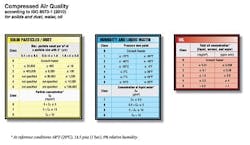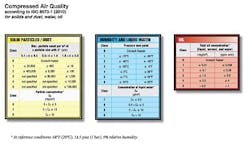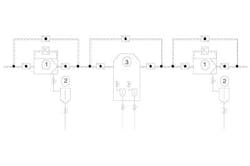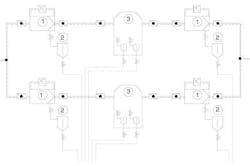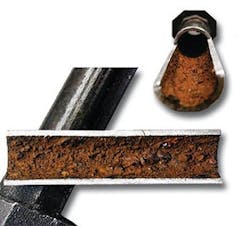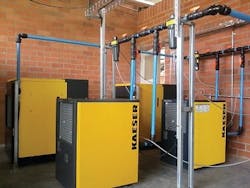How to Select the Right Compressed Air System
In the pharmaceutical industry, compressed air is used for a number of production and packaging applications, including blowing off and drying bottles prior to filling, conveying pills, providing air for pneumatically controlled valves and cylinders, as well as breathing air systems.
Each of these applications requires a different level of air quality and a different combination of air treatment to meet the needed quality. Because the uses of compressed air within the industry vary so greatly, there is no set standard in place that every process must adhere to.
While the FDA may not have issued a directive for compressed air quality in the pharmaceutical industry, there is still a resource available to help select appropriate air treatment components for a compressed air system.
A typical pharmaceutical plant might have a compressed air specification of ISO Quality Class 1.2.1—Class 1 for Solids and Dust, Class 2 for Humidity and Liquid Water, and Class 1 for Oil.
ISO 8573.1:2010 was developed by ISO — the International Organization for Standardization — as a reference for specifying compressed air quality. This standard is not industry or application specific and includes three categories: solid particles/dust, humidity and liquid water, and oil. Within these categories are classes, ranging from 0 to X. While there may not be a pharmaceutical industry standard, the equipment used in these processes may have a certain ISO air quality specified, making it relatively easy to select compressed air dryers and filters to meet the specification.
Once the facility engineer has selected the appropriate air treatment components to meet the required level of air quality for the process, it's important to understand installation considerations that can impact the air quality and overall reliability of the compressed air supply.
Unfortunately, there is often a fundamental disconnect between selecting equipment and installing it. When there is not a clear understanding of how the individual components work together to create a system or why they were chosen to achieve a certain goal — for example, to attain a specific level or air quality — installation decisions can be made that negate system goals.
A common installation consideration is whether or not to include manual bypasses around the air treatment. There are different schools of thought concerning this practice, but before including them for the sake of convenience, consider how they affect air quality.
1: Refrigerated Dryer, 2: Filter, 3: Automatic Condensate Drain
Here is an example of what the air treatment part of a system with a manual bypass might look like:
In this example, the two “NC” (normally closed) valves can be manually opened and the two valves closest to the refrigerated dryer and filter can be closed in case of maintenance, service or failure. The air supply would not be interrupted, but it also wouldn't be treated. Therefore moisture, particulates, and other contaminates which are normally removed would be passed along to the distribution system and adversely affect product quality at the point of use. Since many processes in the pharmaceutical industry have a low tolerance for impurities, bypassing air treatment for the sake of flow is generally not acceptable.
1: Filter, 2: Automatic Condensate Drain, 3: Refrigerated Dryer
The following shows an example of installing air treatment in parallel:
Piping dryers and filters in parallel allows for built-in redundancy, which does increase capital costs, but it also ensures a reliable level of air quality. With this approach, the components are sized so if one of the trains were to be offline for any reason, the other could still meet the demand. If sized properly, one section can be closed off without disrupting the air supply or the air quality. Furthermore, leaving both trains online will reduce pressure drop and wear and tear on the components, which could offer savings in the long run.
Additionally, when adding multiple dryers in parallel it is highly recommended to select dryers with energy saving controls. If energy is an important consideration, then the dryers (whether they be desiccant or refrigerated dryers) should have some sort of energy management control on them to reduce the overall power consumption associated with each dryer. As a safety precaution, it is recommended to consider a high velocity control valve, also called an air main charging valve, which acts to separate the supply from the demand during start-up.
During start-up, flows can range between 8 and 14 times normal air velocity. This excessive flow can damage air treatment equipment and/or pass contaminants on to the point of use. The high velocity control valve allows the supply side (prior to the last air treatment component in the compressor room) to pressurize first, and then slowly pressurizes the remainder of the facility.
Additional communications capabilities allow connecting the dryer with the high velocity control valve. In the event of a dryer failure or alarm, the dryer can send a signal directly to the high velocity control valve to close, thereby ensuring air quality. With a fully redundant dryer and filtration like that shown in Figure 3, all the compressed air would then be routed through the functioning dryer, supplying the necessary air quality level at all times.
Piping with rust and scale build up over time.
Furthermore, the piping material selected can have a significant effect on the air quality level of the system. Piping such as black iron or galvanized iron that will be subjected to moisture can rust and scale like that shown in Figure 4. This rust and scale can then be sent downstream to dryers and filters, causing premature failure of these components, and/or downstream to the point of use. Stainless steel, copper and aluminum are better piping material alternatives for
maintaining air quality.
In determining whether to use bypass piping or not, think about how important air quality is for your application. Can your process tolerate excess moisture for any period of time? Will having contaminants cause product rejects or damage equipment? When put this way, most compressed air users tend to say that they need to maintain a certain quality of air — after all that's why they have the air treatment components in the system in the first place.
Piping air treatment in parallel provides built-in redundancy and ensures a reliable supply of air quality.
The system diagrams included in this article are just two examples of air treatment combinations. If you are not sure what type of filtration or dryer you need, consult a compressed air expert that can discuss your application with you and help not only select the right combination of components to meet your air quality needs, but also properly size the equipment based on your ambient conditions.
ABOUT THE AUTHOR:
Neil Mehltretter is Kaeser's System Design and Engineering Manager. For more information, visit www.us.kaeser.com or email Neil at [email protected].
